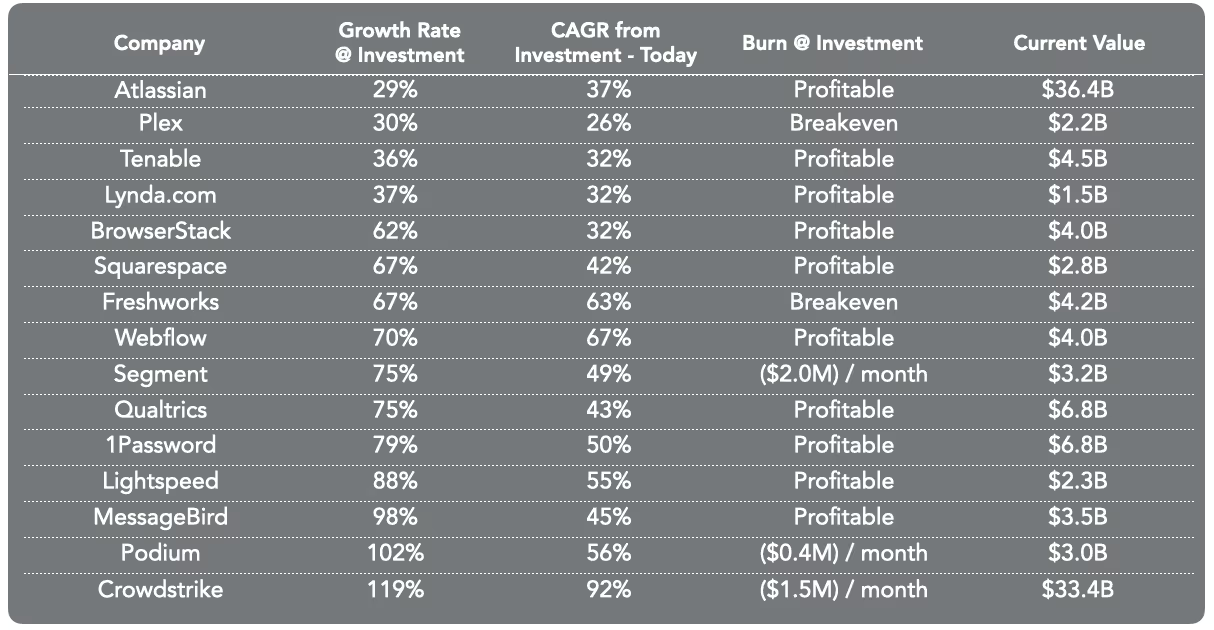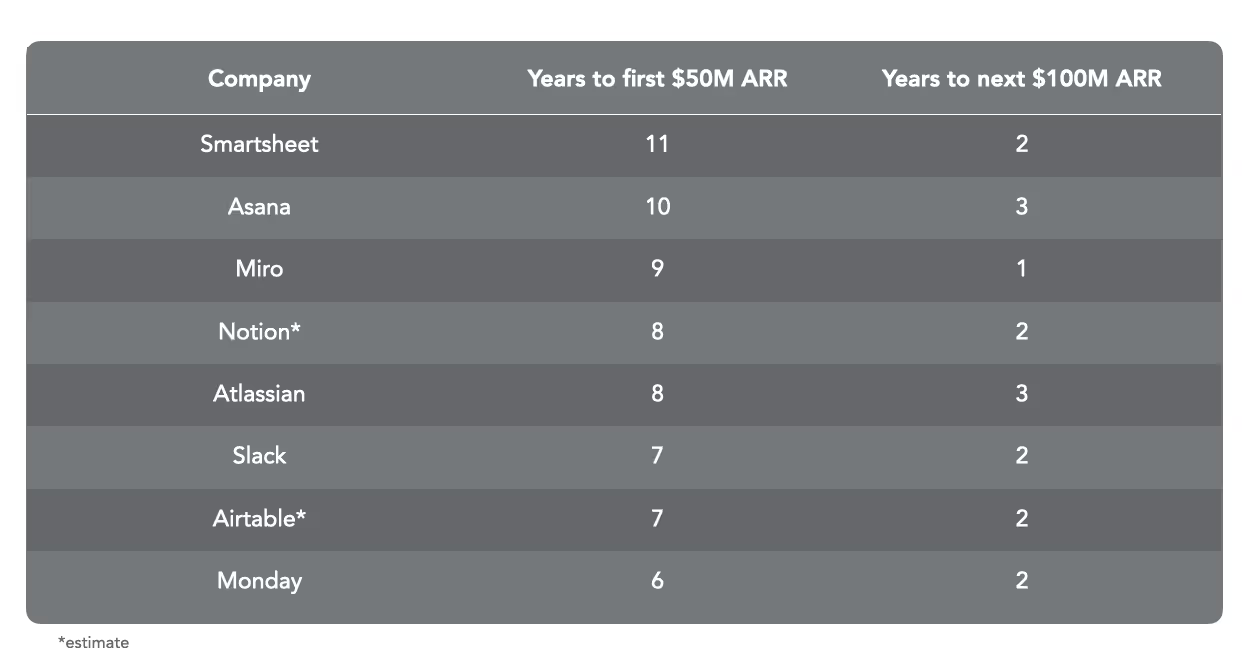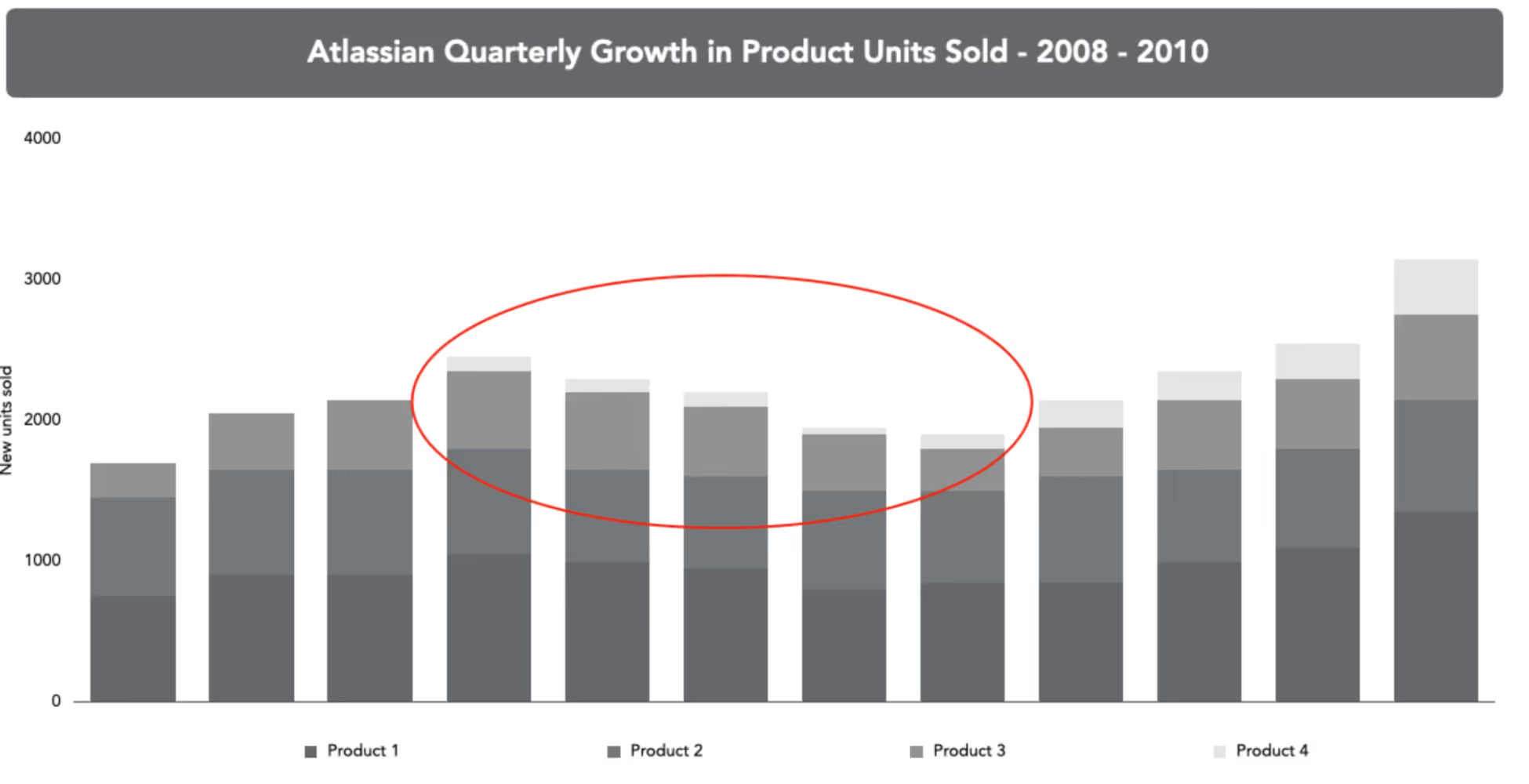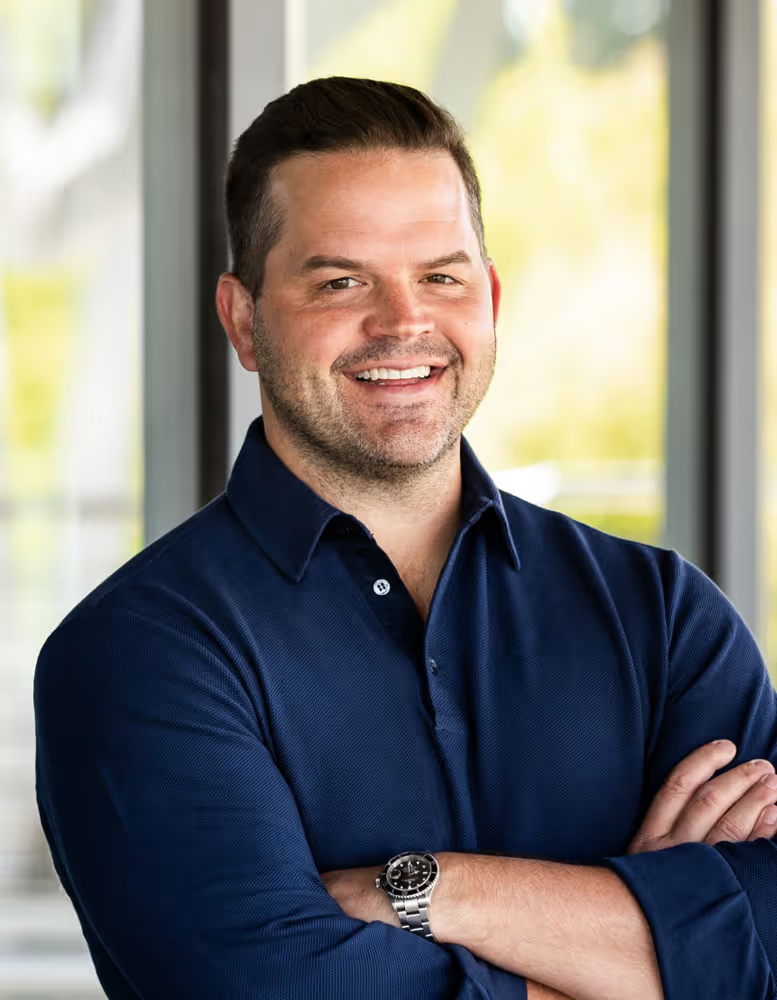Control Your Growth, Control Your Future

Founders have been through a lot this year, and there are plenty of signs that we’re far from the bottom of this market. Yet as we look to 2023, there is reason to be optimistic.
If we’ve just emerged from an era that glamorized “blitzscaling,” we’re likely now in the era of durability. Today there is a healthier focus on “controlled growth”: sustainable growth rates, careful tuning of your company’s flywheel mechanics, slow and deliberate team building, and a shared expectation that the company-building journey is long but rewarding.
The climate feels eerily similar to that of the 2008 - 2011 era. Accel had just launched its dedicated growth investing effort, which allowed us to partner with companies like Atlassian (29% growth at the time of investment, 30% cash flow margins), Squarespace (67% growth, 34% margins), Qualtrics (75% growth, 53% margins), lynda.com (37% growth, 27% margins), and Crowdstrike (which at the time was selling incident response services mostly to government agencies). In those days, founders like Mike Cannon-Brookes, Scott Farquhar, Anthony Casalena, Ryan Smith, Lynda Weinman, and George Kurtz focused on springloading their companies for durable growth. They weren’t fixated on grabbing the next $xx million of ARR; rather, they were obsessed with building the core of the company - a discipline which has yielded $8 billion of combined revenue between those companies alone, as they continue to compound at meaningful scale.
Growth is difficult to fit into a neat framework, and great companies are constructed in many different ways. But with teams now engrossed in 2023 planning, many are asking what the “new normal” might look like. A focus on intrinsics - not arbitrary growth benchmarks - is likely to yield generational companies whether the cycle improves or not.
Founders have taught us a lot over the years about the controlled growth playbook. Patient teams dedicated to building the core of their companies might not demonstrate near-term “hypergrowth,” but they’re more likely to craft flywheel business models with real levers of expansion that allow them to compound with time. With thanks to those founders, we’re sharing back a few lessons and observations with our community.
.avif)
What is the “New Normal”?
Many of the best companies in the world never grew at lightning speeds. It’s unhelpful to be prescriptive about growth rates, because in reality growth itself is a crude lagging indicator. It can be juiced (through paid marketing, or one-off deals that are hard to replicate), and it can be a false positive (aided by a frothy economic environment, selling to other tech companies flush with VC cash, etc). Fixating on growth rate alone obscures the quality of revenue - for that reason the “new normal” is likely to be more qualitative than quantitative.

Consider a few companies that we’ve been fortunate to work with. Each created billions of dollars of customer value on the back of sustained growth rates that in many cases never eclipsed 50% - but they continue to grow efficiently, durably and predictably in large end markets that have enabled them to compound for many years.
The Flywheel Inputs
Rather than triangulate on growth rates as a proxy for success, companies are better served to focus on their flywheel inputs - the qualitative levers established in your formative years that have exponential impact on future sustainability. Here are a few common traits of controlled-growth, flywheel companies that have inspired us over time:
Product quality: Product vision transcends A/B tests, which can help you make incremental progress towards an end state no one really asked for. Rather, establish a regular pulse with your customers to understand whether your roadmap actually resonates. Ask what they don’t like about the product instead of seeking affirmation. Build a culture of shipping and constantly seek qualitative feedback. Over time a high-NPS product will be reflected in usage intensity (historically >40% DAU/MAU is elite, with the SaaS average hovering around 14% and the SaaS 90th percentile at 30%), and in the % of your pipeline that’s inbound (>30% organic inbound lead flow is similarly excellent). In increasingly crowded markets product philosophy can emanate from very subtle insights; for example Miro founder Andrey Khusid says frequently that “details matter” - small things done right create big impact and lasting effect. That belief defines the core of a product which has reached 45 million active users across 99% of the Fortune 100, with more than 60% of the funnel completely organic.
Leverage in the model: A business model with leverage allows for more consumption of your product(s) by more people without any incremental GTM investment. Or, think of this as the marginal ease of ARR accumulation. There’s nothing intrinsically wrong with rapid commercial traction; the problem is when scaling revenue requires scaling headcount. Simple sales arithmetic often misses the hidden burden of hiring new sales capacity, when a single AE also requires 1-2 SDRs, and eventually the support of solutions engineers and sales ops professionals, new hiring managers to bring in more candidates, more IT resources to accommodate a growing workforce, and so on. A self-serve motion can remove much of this friction from the initial land, but everything that happens downstream (onboarding, support, upsell, etc) carries the same hidden burden. Flywheel companies win customers with as few touchpoints as possible- ideally via word of mouth- and automate the expansion path such that incremental revenue accrues without incremental spend. A great example is 1Password, which grew from 0 to 50,000 customers without any salespeople or marketing investment. Today 1Password gives every new business user a free personal account, which adds roughly 50,000 new active users per year who share the product with friends and family, adding additional momentum to the flywheel at very little marginal cost.
Healthy customers you can grow with: Not all customers are created equal - it’s impossible to stack recurring revenue if your initial customer base switches products regularly or is disproportionately likely to go out of business. Having an early customer mix across a wide range of industry, geography, and revenue profiles helps provide a stronger foundation that can withstand bumpy economic cycles. Consider putting extra resources behind customer archetypes that have strong tailwinds you can grow with (such as Braintree equipping the on-demand economy with payment APIs, or Atlassian empowering developers in the onset of the DevOps movement, or CrowdStrike selling endpoint security against a backdrop of cyberwarfare and visible security beaches). Find healthy customers, become instrumental to their growth, and you’ll create a symbiotic relationship with compounding effects.
Availability of downstream levers: Put most simply, you want to see intense utility from your core product(s) for the core users within a company, and eventually new utility for future products introduced to future users within the company. There’s no one single winning strategy- for some companies offering shallow but highly useful functionality for a deep user base wins (Slack providing messaging to every employee at a company), while others might go deep in functionality for a vertical user community within a company (Figma, starting with EPD teams and expanding to non-designers). The steps to realize your product vision will naturally take many years, but establishing an operating thesis on how to sequence act one, act two, act three and beyond is important. There is a parallel question of what features and workflow you want to own, versus what you might cultivate from an ecosystem of partners. Push yourself to think three years ahead on what downstream levers you might introduce, and reserve the right to reevaluate your views based on customer feedback.

A vibrant ecosystem: Eventually, flywheel companies engender enough pull from customers and foster sufficient connectivity with IT partners that an ecosystem takes shape to feed vibrancy back into the user experience. Ecosystems are a flywheel amplifier because they enable companies to evolve from intrinsic network effects to inter-company network effects. The power of a successful ecosystem can be channeled in countless ways- it can inspire use cases, enhance a product experience, deepen workflows, facilitate customer meetups, address long-tail feature needs, or even fund the next wave of technology partners. An ecosystem may have its early roots in something as simple as a Slack channel or Discord server that organically connects users, but when supported by a commercial framework an ecosystem can generate powerful network effects over time: the Atlassian Marketplace consists of 1,250 partners who enable 28,000 app installs weekly, with over $2 billion of sales generated for partners over the last decade.
Value for usage: In the early days of SaaS a lot of software was oversold- customers were pushed into license counts they wouldn’t grow into, many seats were never activated, blended utilization remained low, and over time ROI became murky. Today, with the help of metered consumption models this paradigm has flipped, better aligning the interests of the software consumer and the software seller. Great flywheel software businesses help their customers feel that they’re always getting value from their investment. Slack’s Fair Billing Policy is a great example. While Slack built an array of internal metering and billing systems to enable this experience, today there’s a growing ecosystem of third party tooling available off-the-shelf to make this process seamless for companies of all sizes.
Building Talent Flywheels
There’s great benefit to growing your team at a controlled pace too. We’re starting to see the next iterations of the “PayPal / LinkedIn mafias” from a handful of exceptional companies who have demonstrated deliberate team building. Great talent begets great talent, and with each early hire you further cement your hiring reputation- the talent function itself can be its own flywheel. There are many approaches to recruiting but great teams tend to be built slowly atop a cohort of excellent managers. Instill a culture that rewards both mentorship and individual contribution, and scale only once those managers are so overwhelmed with important work that they need to go hire people who share their best traits. Identify great candidates who are not available and work hard to pry them loose. Expect that this will take time. Be diligent with references to avoid what one excellent executive in the Accel family refers to as “hollow chocolate” - people with immaculate resumes of world-class companies, who didn’t actually have their fingerprints on what made those companies great. Like the business model itself, your early core of talent can have outsized downstream impact if you build it gradually with care and patience. Consider the hiring track records of Slack, Dropbox, Segment and Atlassian whose alumni have largely gone on to seed the next generation of bottoms-up talent.
%252520(1).avif)
No Shortcuts
Collaboration software companies often exemplify great flywheel businesses. As a rough rule of thumb, it takes 8-10 years to “springload” these companies, and a much shorter time period to see the effects of compounding. Consider the companies below- we’re grateful partners to some of them, and simply admirers of the others- in every case it took the better part of a decade to reach scale (arbitrarily defined as $50m ARR), but only ~24 months to triple from there. The inputs during those springloading years have clear exponential impact on everything that follows.

These 8-10 years of springloading are the time to build the core of your company. The stronger the core, the more likely to compound. They also afford you the opportunity to practice craftsmanship. Do artisanal things that may not scale. For example, at some point you will be so large that it won’t be practical to speak to every customer. Early on, you should try to.
Push during these years to uncover the non-obvious drivers of the business. Chances are your customers’ actual eval behavior, buying cycle and path to upgrade are not exactly like any other company, and may not fit a neat framework. Take a first principles approach to understanding why, when and how people fall in love with your product. Don’t be nervous if it’s a little different than what’s conventional. Don’t run from unconventionality; embrace it.
These years are also the time to build the scaffolding for analytics (hat tip to Zhenya Loginov for this advice). Establish a common language of data through analytics, reporting and benchmarking. When growth starts inflecting, you’ll better understand why and be able to adapt more quickly.
When Controlled Growth Can Save Your Company
We got to know Mike and Scott from Atlassian in the heart of the great financial crisis. Three quarters before we invested, the Y-o-Y quarterly growth rate slowed to an anemic 5%. For four straight quarters, the number of new licenses sold declined. Conventional logic might have suggested raising prices to offset slowing volume, as incumbents like IBM Rational and Microsoft Visual Studio were substantially more expensive.

With clear conviction and a resolute understanding of their business drivers, Mike and Scott did the opposite: they lowered prices and introduced starter licenses (free seats for small teams), sacrificing near-term revenue but flooding the user base with new upsell opportunities. They made that decision in year 9 of Atlassian, and since the date of that decision, the Atlassian flywheel has generated $3.2 billion of new revenue. A hardened understanding of what drives your business will embolden you to make the right call when times get tough.
Better Times Ahead
We’re still in an era of austerity- yet our team at Accel is more optimistic than ever about the company building opportunity ahead. Constraint forces focus, and the gritty resolve of founders to reshape their companies will be rewarded. The ethos of the “hyper growth” era was misguided, distracting and not the way company building was ever meant to be. Now’s the time to solidify the intrinsics, and get in a position to profitably explode at a pace you can sustain.
Of course, some companies find instant product/market fit in landgrab categories with an offering that deeply resonates - Slack, Remote, Celonis, Dropbox, UiPath and others grew exponentially when we partnered with them. Still, the controlled growth mindset is a healthy discipline to guard against future competitive threats, market cycles, and forces of deceleration.
We’ll continue to see companies of all shapes, sizes, strategies and growth trajectories thrive, and we’re excited for the next generation of iconic technology companies to take flight in the coming years. A particularly vibrant set of opportunities will emerge behind the controlled growth playbook - yielding flywheel companies that endure the current cycle and thrive for decades to come.
Great companies aren't built alone.
Subscribe for tools, learnings, and updates from the Accel community.

